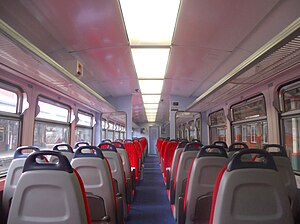British Rail Class 153
| British Rail Class 153 Super Sprinter | |
|---|---|

East Midlands Trains Class 153 No. 153381 at Peterborough
|
|

The refurbished interior of a East Midlands Trains Class 153
|
|
| In service | 1991/2 – present |
| Manufacturer |
British Leyland Converted to Class 153 by Hunslet-Barclay |
| Order number | 31026 |
| Built at | Hunslet-Barclay Kilmarnock (conversion) |
| Family name | Sprinter |
| Replaced | First generation DMUs |
| Constructed |
|
| Entered service | 1991 |
| Refurbishment | Various |
| Number built | 70 |
| Formation |
|
| Diagram |
|
| Fleet numbers |
|
| Capacity | 66 or 72 |
| Operator(s) | |
| Depot(s) | |
| Specifications | |
| Car body construction | Steel underframe. Aluminium alloy body and roof. |
| Car length | 23.208 m (76 ft 1.7 in) |
| Width | 2.700 m (8 ft 10.3 in) (over body) |
| Height | 3.746 m (12 ft 3.5 in) (over body) |
| Doors | Single leaf sliding plug |
| Articulated sections | Single car |
| Wheelbase |
|
| Maximum speed | 75 mph (120 km/h) |
| Weight | 41.2 t (40.5 long tons; 45.4 short tons) |
| Prime mover(s) | 1 × Cummins NT855R5 |
| Engine type | Diesel |
| Power output | 285 hp (213 kW) |
| Transmission | |
| Train heating | Warm air, hot water radiators |
| UIC classification | Bo'2' |
| Bogies |
|
| Braking system(s) | Air/EP |
| Safety system(s) | |
| Coupling system | BSI |
| Multiple working | Classes 14x, 15x, 17x |
| Headlight type | Fluorescent |
| Track gauge | 1,435 mm (4 ft 8 1⁄2 in) Standard gauge |
| Notes | |
| Converted from 35 × Class 155 sets | |
The British Rail Class 153 Super Sprinters are single-coach diesel multiple units converted from two-coach British Rail Class 155s. The class was intended for service on rural and branch lines where passenger numbers do not justify longer trains.
In the late 1980s, British Rail took delivery of 35 two-coach Class 155 units from British Leyland to replace older Regional Railways DMUs. Shortly after, West Yorkshire PTE took delivery of 7 two-coach units for use in the Yorkshire region. After the Class 155s entered service, it became an emerging requirement for ageing rural and branch line trains to be replaced. In the early 1990s, BR decided to go forward with plans to convert the Regional Railways Class 155 fleet into single-coach multiple units and to replace its fleet of Class 121 and 122 diesel railcars.
In 1990, British Rail issued a contract to Hunslet-Barclay at Kilmarnock for conversion of the Class 155 units. From 1991 to 1992, the 35 two-coach Class 155 units began to emerge from the works as single-coach Class 153s. A total of 70 single-coach class 153 multiple units were created which were numbered in the range 153301-335 and 153351-385. Individual coaches are numbered 52301-335 and 57351-385 (originally 57301-335).
The layout of the original non-cab ends was different from the original cab end, so the ends are noticeably distinct, and the vehicles are not symmetrical. The 7 West Yorkshire PTE Class 155s were not modified and remained as two-coach class 155 multiple units.
Their maximum speed is 75 mph (121 km/h) and suited for working less widely used local services such as the London Midland service from Coventry to Nuneaton and the Heart of Wales Line. They are fitted with standard BSI auto-couplers and are therefore able to work in tandem with other multiple units fitted with the same coupler, including classes 142, 143, 144, 150, 156, 158, 170 and 172.
...
Wikipedia
